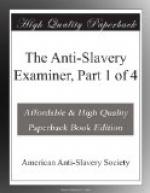2. The act was violence to nature—a suicide on constitutional susceptibilities.
3. The parental relation then, as now, was the centre of the social system, and required powerful safe-guards. “Honor thy father and thy mother,” stands at the head of those commands which prescribe the duties of man to man; and, throughout the Bible, the parental relation is God’s favorite illustration, of his own relations to the whole family of man. In this case, death is inflicted not at all for the act of smiting, nor for smiting a man, but a parent—for violating a vital and sacred relation—a distinction cherished by God, and around which, both in the moral and ceremonial law, He threw up a bulwark of defence. In the next verse, “He that stealeth a man,” &c., the SAME PRINCIPLE is wrought out in still stronger relief. The crime here punished with death, is not the mere act of taking property from its owner, but the disregarding of fundamental relations, doing violence to an immortal nature, making war on a sacred distinction of priceless worth. That distinction which is cast headlong by the principle of American slavery; which makes MEN “chattels.”
The incessant pains-taking throughout the old Testament, in the separation of human beings from brutes and things, shows God’s regard for the sacredness of his own distinction.
“In the beginning” the Lord uttered it in heaven, and proclaimed it to the universe as it rose into being. He arrayed creation at the instant of its birth, to do it reverent homage. It paused in adoration while He ushered forth its crowning work. Why that dread pause, and that creating arm held back in mid career, and that high conference in the godhead? “Let us make man in OUR IMAGE, after OUR LIKENESS, AND LET HIM HAVE DOMINION over the fish of the sea, and over the fowl of the air, and over the cattle, and over all the earth, and over every living thing that moveth upon the earth.”
Then while every living thing, with land, and sea, and firmament, and marshalled worlds, waited to catch and swell the shout of morning stars—THEN “GOD CREATED MAN IN HIS OWN IMAGE. IN THE IMAGE OF GOD CREATED HE HIM.” This solves the problem, IN THE IMAGE OF GOD CREATED HE HIM. Well might the sons of God cry all together, “Amen, alleluia”—“Thou art worthy, O Lord, to receive blessing and honor”—“For thou hast made him a little lower than the angels, and hast crowned him with glory and honor. Thou madest him to have dominion over the works of thy hands; thou hast put all things under his feet. O Lord, our Lord, how excellent is thy name in all the earth.” Psalms viii. 5, 6, 9. The frequent and solemn repetition of this distinction by God proclaims his infinite regard. The 26th, 27th, and 28th verses of the 1st chapter of Genesis are little else than the repetition of it in various forms. In the 5th chapter, 1st verse, we find




